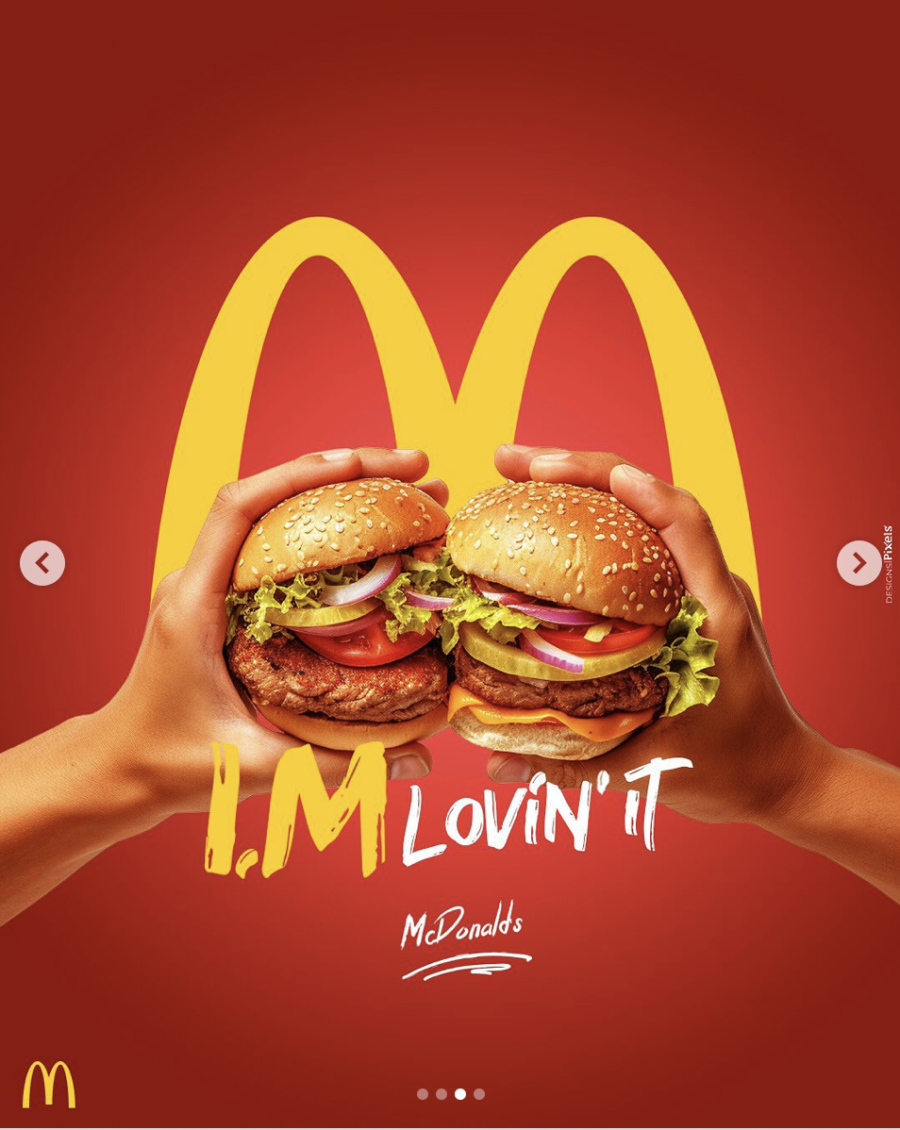In our daily life, we can see McDonald’s advertisement posters displayed everywhere, such as in subways, stations and other public places. So, what kind of understanding would people have when they see these advertisements? In this blog, I will analyse a McDonald’s “I’m Lovin’ It” advertisement to explore Stuart hall’s Encoding and Decoding model. The image shows two hands holding up two burgers against a bright red background. Behind them is a large yellow McDonald’s “M” logo, and the slogan “I’m Lovin’ It” appears in a casual, handwritten style. The poster looks simple at first, but Stuart Hall suggests that media messages are not taken in passively. Different people understand media in their own ways, depending on their background, experience and personal beliefs. This advertisement shows how one picture can produce several different types of meaning for different audiences.
Dominant Reading
The dominant reading accepts the message that McDonald’s wants to communicate. The hands lifting the two burgers suggest sharing and enjoyment, which makes the brand look like part of a fun social moment. The warm colours create a sense of excitement and comfort, and the slogan “I’m Lovin’ It” presents eating McDonald’s as something that brings simple happiness. From this perspective, the viewer may see the advertisement as a celebration of low-cost pleasure and everyday comfort. In this preferred meaning, McDonald’s becomes a positive, youthful and enjoyable brand that fits easily into daily life.
Negotiated Reading
A negotiated reading agrees with some parts of the message but questions others. Many people enjoy McDonald’s from time to time and find it convenient or comforting. They may think the burgers look tasty and understand why the brand is popular. At the same time, they also know that fast food is not very healthy and can be high in calories. A viewer might find the image fun and attractive but feel unsure because they know the emotional message is slightly exaggerated. In this interpretation, the audience accepts the general idea but still has concerns about the product, especially about health or frequency of consumption.
Oppositional Reading
An oppositional reading rejects the message completely. From this viewpoint, the advertisement may look manipulative and connected to wider problems with fast-food culture. The strong red and yellow colours could be seen as a technique to stimulate appetite and encourage people to buy more. The slogan “I’m Lovin’ It” may be interpreted as hiding the negative health effects of fast food, such as weight gain and poor diet. Some critics might argue that the poster targets young people and low-income groups by promoting cheap but unhealthy meals as a form of happiness. In this view, the advertisement is not about joy but about a marketing strategy that uses emotion to sell unhealthy products.
Overall, this McDonald’s advertisement demonstrates Hall’s idea that media messages do not have only one fixed meaning. The company encodes a message of pleasure, sharing and positivity, but different audiences decode it in different ways. Some people fully agree with the message, some partly accept it and some reject it completely. This example shows that even a simple fast-food poster carries social meanings and emotional messages, and audiences play an active role in shaping how these meanings are understood.
References
Hall, S. (1980). Encoding/Decoding. In S. Hall, D. Hobson, A. Lowe and P. Willis (eds.) Culture, Media, Language. London: Hutchinson.


hello.
You apply Hall’s model cleanly and keep the readings grounded in specific visual cues (the lifted burgers, red/yellow palette, handwritten slogan). A few angles you might add to deepen it: the “handwritten” script codes intimacy and authenticity, softening corporate voice; the faceless, cropped hands de-particularize identity, inviting broad self-insertion (age, class, ethnicity), which supports a dominant reading of communal pleasure. Color is doubly interesting: beyond appetite-stimulation, red can signal celebration (in some cultures) and urgency/sale (in others)—a neat entry point for cross-cultural negotiated/ oppositional readings. The twin burgers subtly encode sharing and value, hinting at price logic without stating it.
Methodologically, discourse analysis could be enriched with brand “codes” (logo, jingle/ tagline, colorway) and layout grammar (salience, framing) to track how meaning is orchestrated across elements. Reception-wise, segment audiences—parents with kids, students, shift workers—to show how convenience, price, and health discourses reweight the negotiated reading. For an oppositional layer, you might note how the poster’s cheerfulness erases labor, supply chains, or nutritional disclaimers, reframing “I’m Lovin’ It” as affective capture.
You show a clear classify of three ways of decoding and use famous company MCDonald as example, just focus on one point to make a statement of different type of meanings. And I suggest you can analyse more about why different audience will have different understanding of the same slogan, what factors influenced the way people decoding it, this factors may not only are visual effects, but also something constructed from social and cultural background or the class of different people.
It’s really a brilliant idea to use the brand McDonald’s as an example. On the one hand, it is an international big brand with wide popularity and a large audience. On the other hand, its advertising forms are diverse and very classic. As an advertisement, during the decoding process, we need to confront three different attitudes. Therefore, as a coder and an advertisement producer, perhaps we should clearly define the profile of our main target customer group and try to encode in a way that most decoders can understand, so as to achieve better sales